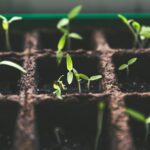My seed planting in the past has always been quite small scale and I have had little need to plant for a continual harvest as I never had a high enough yield to call for a continuous harvest. Now that I have built this large raised garden bed, I have more space to grow vegetables, but I don’t want them all to be ready for harvest at the same time! First off, that would be a lot of work to harvest everything at the same time! But in addition to having a lot of work to do, I would then have a whole lot of vegetables, more than my family could eat before they went bad. So this lead me to learn about continual harvests and how to plan for succession planting.
A continuing harvest is when your vegetables will be ready for harvesting at varying times throughout the season, in my case spring through to fall based on the vegetables I am planting. In order to prepare for a continuous harvest I need to plan for succession planting. Succession planting is a way of staggering propagation of the seeds, or in other words, varying the times you plant seeds so the vegetables will be at full maturation at varying times throughout the season.
This past weekend my daughter and I pulled out the packets of seeds we had purchased and we looked on the back to find the various information for growing these vegetables, such as when to plant, where to plant, how far apart to plant, and how often to plant for a a continual harvest. I found a wonderful resource that talks about what successive planting is and breaks down different ways to do it offering tips and tricks to help you be successful.
When reading through this website I learned about the three sisters method of planting corn, beans, and squash which is a method of intercropping and wanted to learn more! I learned that the three sisters crops are referring to corn, beans, and squash. This method was traditionally used by indigenous peoples on Turtle Island in various regions. The interconnectedness of these three crops being planted together create a rich and thriving environment for all three to grow as they all have qualities that benefit each other.
When these three vegetables are grown together the corn provides tall stalks for the beans to grow up on so that they are not overrun by the squash vines and in turn the beans provide stability for the corn stalks in heavy winds. The beans provide a nitrogen rich soil by taking nitrogen from the air and converting it to forms that can be absorbed by plant roots, providing benefit to both the corn and the squash. The squash leaves grow large and offer protection for the soil to retain moisture and discourages the growth of weeds. I have always thought that it is important to provide proper spacing and separation for the healthy growth of seeds, however, I am learning that there is great benefit growing some seeds together in providing a rich environment for the plants to thrive. The website that taught me more about the three sisters planting was really helpful in breaking it down and explaining where it came from and why it is beneficial.
Another method I learned while reading about succession planting is planting different plants in the same space. When you are planting your next round of seeds, instead of planting the same seeds in the same area, vary where you plant your seeds to allow for maximization of space when crops are growing at varying stages from maturity to sprouting.
I am not sure which method I will use when it is time to plant and I may even experiment with different methods and compare what works best for my garden and the species of vegetables I have chosen. I cant wait for the last frost so I can plant all of my seeds and watch them sprout up!





